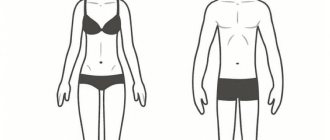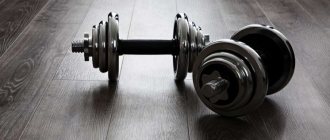Creating a two-day split[edit | edit code]
Two-day split
Well, finally, the first stage of the training has been completed - circuit training, and you can move on to the next stage, which involves separate training of muscle groups, otherwise called split. The working weights have increased and it becomes impossible to fully pump the entire body in one workout. In addition, the body muscles no longer have time to recover for the next workout due to the same reason for the increased weights. Therefore, the muscles are divided into several groups, each of which is worked out in a separate workout. At first, for several months you will have to work out in a two-day split - the muscles of the body are divided into two groups. Three training sessions are held per week. Usually muscles are divided according to the “up-down” type or the “pull-pull” type. “Upper-bottom” means that in the first workout the muscles of the upper body are loaded, and in the second - the lower body. A push-pull split means doing a variety of pulls in the first workout and bench presses in the second. Below are some examples of two-day splits using different ways to separate muscle groups.
Two-day training program
The two-day mass split is great for both beginners and more experienced bodybuilders who are not using anabolic steroids. As you know, the growth of muscle mass without the use of steroids is possible only if the working weights in the exercises are constantly increased. However, most gym goers are in a deep state of stagnation. Due to the blind copying of champion training programs with which the entire Internet is littered, a natural’s body simply does not have time to recover, which leads to a state of overtraining in which there can be no talk of any progress. A two-day mass split allows for full recovery between workouts, which will have a positive effect on increasing the athlete’s working weights and muscle mass. With this training program, you are guaranteed to be able to break through plateaus and reach the next level. Tested by personal experience!
The most common options for constructing a two-day split are “TOP-BOTTOM” and “PULL-PUSH”. According to the first option, in the first workout you work the muscles of the upper body (CHEST, BACK, ARM), and in the second workout the muscles of the lower body (LEGS, PRESS). According to the second option, in one training session you work out pulling muscle groups (MUSCLES OF THE BACK AND BACK OF THE THIGH, BICEPS OF THE ARMS), and in another training session pushing muscle groups (CHEST MUSCLES, TRICEPS, FRONT DELTO, QUADRICEPS). For clarity, I will give examples of both options for a two-day weight split.
Program 1[edit | edit code]
Top-bottom muscle separation. In the first week, two upper and one lower workouts are performed. In the second - two bottoms and one top. Trainings are held on Mondays, Wednesdays and Fridays.
For example:
Monday is the first workout, Wednesday is the second, Friday is the first, Monday is the second.
First training. Top[edit | edit code]
The main muscle groups of the upper body are the back, chest, deltoids and arms. For each of them, at least one basic exercise must be performed. Based on this, the training is built.
- Bench press on a horizontal bench 3x8-10
- Fly (or press) on an incline bench. 3x8-10
- Upper pulley to chest 3x8-10
- Bent-over barbell row (or seated chest row) 3x8-10
- Seated barbell press in Smith machine 3x8-10
- Standing biceps curl 2x10-12
- Vertical block downward triceps press 2x10-12
Second training session. Bottom[edit | edit code]
- Squats with a barbell on the shoulders 3x8-10
- Platform leg press 3x8-10
- Deadlift 3x8-10
- Deadlift on straight legs 3x8-10
- Lying leg curls in a special machine 3x8-10
- Standing calf raises in the machine 2x12-15
Advantages and disadvantages of this type of training
For gaining muscle mass, the split system is considered perhaps the best tool. Especially when it comes to beginners and advanced athletes, that is, everyone who does not use illegal drugs. I consider the main advantages of splitting:
- The ability to effectively work each muscle in two workouts.
- Suitable for any type of training (strength, mass, endurance, etc.).
- There is no direct need to work with a trainer (the program can be easily compiled even with minimal knowledge. It is enough to understand the types of exercises and what muscles they load).
- No muscle imbalance.
- The central nervous system is not overloaded.
- No risk of overtraining.
- Suitable even for busy work schedules.
It doesn’t matter whether you work in a 5/6+1 mode, or in two-by-two shifts, setting aside 60-70 minutes twice a week won’t be difficult. This will be enough for stable growth if you take into account the progression of the load and do not constantly work with the same weights. Moreover, the split is completely universal, it is suitable for girls and women, older people and teenagers. Can be used both to prepare for competitions and during the rehabilitation period after injuries.
The split system has no obvious disadvantages; almost all the disadvantages lie in a negligent approach to the matter. Therefore, to eliminate potential disadvantages, you need to monitor the following features:
- Load planning (properly combine traction and pressing types of exercises, working out muscle groups, etc.).
- Maintain high intensity (rest, sets, repetitions, working weights and other factors). Remember, you only train twice a week, so your workouts should be intense.
- Monotony of training.
The last point for natural athletes, that is, athletes without pharmaceutical support, is the most destructive. Monotony quickly leads to adaptation, after which the body will not respond to the load properly (first of all, hormonal release decreases). This will lead to slower progression in muscle gain and loss of strength. Therefore, don’t make the same mistake that I’ve been seeing in gyms for years – don’t fall into a routine. Using the same split program month after month is truly suicide. With this approach, the effectiveness of training will constantly decrease. The maximum period for classes according to the same scheme is 8 weeks.
Program 2[edit | edit code]
Based on the exercises given above, or adding them a little, you can vary the split systems. For example, add deltoids or arms to the training of legs, respectively, removing them from the first training to the top. Then the split might look like this:
First training[edit | edit code]
- Incline bench press 3x8-10
- Dumbbell fly on a horizontal bench 3x8-10
- Upper pulley to chest 3x8-10
- Bent-over barbell row 3x8-10
- Standing biceps curl 2x10-12
- Dips with weights 2x10-12
Second training[edit | edit code]
- Squats with a barbell on the shoulders 3x8-10
- Platform leg press 3x8-10
- Leg curls in the machine 3x8-10
- Standing calf raises in the machine 2x12-15
- Seated vertical chest press in Smith machine 3x8-10
- Dumbbell swings from the sides up while standing 3x10-12
- Dumbbell swings while standing at an incline 3x10-12
Principles of creating a split
The key to the effectiveness of a split system lies in proper program planning, so I advise you to pay special attention to the principles on which the entire methodology is based. First, you need to decide on a schedule. If you train on a 2-day split twice a week, then everything is simple. If you go to the gym 3 times a week, you will have to alternate workouts.
Regardless of the types of split, combinations of exercises and other conditions, only the following principles are generally accepted:
- In one workout you need to perform no more than 7-8 exercises.
- The maximum permissible number of working approaches is from 20 to 22.
- Effective training time is one hour.
Warm-up and stretching at the end of the workout do not count toward the times listed. That is, in general, your workout should last about 80-90 minutes. An hour is allotted for the main work, warm-up 10 minutes, stretching or cardio after training - 10/20 minutes.
Program 3[edit | edit code]
Below is an example of a two-day push-pull split:
First training. Pull[edit | edit code]
- Barbell row (lower block) to the stomach 3x8-10
- Upper pulley to chest 3x8-10
- Deadlift on straight legs 3x8-10
- Lying leg curls in the machine 3x8-10
- Standing biceps curl 3x8-10
Second training session. Push[edit | edit code]
- Squats with a barbell on the shoulders 3x8-10
- Platform leg press 3x8-10
- Bench press 3x8-10
- Incline Dumbbell Press 3x8-10
- Smith machine seated chest press 3x8-10
- Vertical block triceps presses 2x10-12
Brief explanations of the programs[edit | edit code]
These programs do not include abdominal exercises. There are several reasons for this. Firstly, the abs are very heavily loaded during other exercises, such as squats, bench presses, barbell rows, etc. In addition, direct work on the abs is very energy-consuming, and therefore its implementation will negatively affect the recovery and growth of other muscles. That is why one of the most famous trainers, Vince Gironda, prohibited abdominal work in his gym.
Don't forget about a general warm-up before training and one or two warm-up sets of each exercise before performing work.
Remember to vary your workouts. If the first workout began with chest training, then a similar second workout should begin with back training. The only exceptions are squats. Due to their complexity, they should come first on the day of leg training.
Thus, after practicing a two-day split for some time and exhausting its possibilities, you can move on to a three-day split (see Three-day split for beginners).
What is a two-day split?
The split training principle means that we train different muscle groups on different days, rather than the whole body each workout. Therefore, we only have two days to work out all the muscles. It is most rational to conditionally divide our body into top and bottom .
Training principle
In one day, we completely work out all the upper muscles - chest, back, arms, shoulders and abs, doing 2-3 exercises for large muscle groups and one for small ones. This amount of work will be quite enough to keep them in good shape and provide the prerequisites for growth. After two or three days of complete rest after training the upper body, we do a full volume training on the legs, at one time trying to properly load the quadriceps, hamstrings, gluteal and calf muscles.
This way you will have more than enough time to fully recover between workouts. After all, the larger the muscle, the more time it needs to recover. Therefore, it is advisable to make your workouts difficult, giving your full effort in every set of every exercise. This way you will consistently get bigger and stronger when using a two-day split. If you train carelessly, you will not achieve much results - two training sessions a week will not be enough due to the small amount of work.
Of course, there will be no growth even with insufficient nutrition. A calorie surplus of 10-20% of the daily requirement for a particular athlete is required.
Another option for a two-day split:
Recommendations for using the program
The program is suitable for those athletes who:
- There is no time or opportunity to visit the gym often.
- But at the same time there are enough resources (food, sleep) for recovery.
By training on the principle of a two-day split, we work several large muscle groups at once in one session. Therefore, it is worth using mainly only heavy basic exercises, after which you need a long recovery (we have a week for this), and a minimum of isolation. Sometimes it makes sense to add some cardio at the end of your workout. How to competently combine all this for people with different body types, read in the following sections.
This training program requires the trainee to have some training experience, preferably at least 2 months. But, despite the fact that this program is recommended for beginners, experienced athletes, training with it, achieve good results. This program has been tested more than once. The results show that there is a noticeable decrease in body fat while maintaining or increasing total body weight endurance increases significantly , the respiratory system develops , and the heart strengthens.
The training time for this program should be 1-4 months , optimally 2-3 . Gain muscle mass up to 1 kg per month, lose fat without using crash diets up to 4 kg per month.
A special feature of this program is its long cycle – more than 2 weeks . This allows you to load the muscles in different “modes” and avoid their adaptation to the load. The program uses growth-stimulating failure (indicated “refusal”) and auxiliary (other) training. It is strictly unacceptable to violate the given order and regimen; it is only permissible to replace inaccessible exercises with alternative ones.
The training program provides for an increased load for endomorphs (en) and mesomorphs (mes).
| № | Exercise | Approaches | Repetitions | Rest, min. |
| Day 1 (chest, triceps, back) | ||||
| Treadmill workout - 10 minutes (en - 15 minutes) | ||||
| 1 | Barbell head down press | 3 | 8-10 (refusal) | 4-6, 3-5 (en) |
| 2 | Bench press | 4 | 8-10 (refusal) | 4-6, 3-5 (en) |
| 3 | Bent over dumbbell press | 3 | 8-10 (refusal) | 3-5 |
| 4 | Close grip block row | 2 | 12-15 | 1-3 |
| 5 | Block row to the chest or T-row | 3 | 12-15 | 1-3 |
| 6 | Close grip bench press | 2, 3 (en) | 12 | 1-2 |
| Treadmill workout - 5 minutes | ||||
| Day 2 (rest) | ||||
| Day 3 (legs, biceps, abs) | ||||
| Elliptical training – 5-7 minutes | ||||
| 1 | Squats | 5, 6 (en, mez) | 8-10 (refusal) | 5-7, 4-7 (en) |
| 2 | Leg extensions | 3 | 8-10 (refusal) | 3-4 |
| 3 | Leg Curls | 3 | 8-10 (refusal) | 3-4 |
| 4 | Caviar | 5, 6 (en, mez) | 10-15 (refusal) | 2-3 |
| 5 | Biceps on a machine or Scott bench | 3 | 6-10 | 1-2 |
| 6 | Reverse crunches or hanging crunches | 3 | 10-15 | 2 |
| 7 | Roman chair crunches | 3 | 20-30 | 1-2 |
| Day 4 (rest) | ||||
| Day 5 (triceps, chest, back) | ||||
| Treadmill workout - 5 minutes | ||||
| 1 | Dumbbell Bench Press | 2, 3 (en, mez) | 12-15 | 1-2 |
| 2 | Bent over barbell press | 3 | 12 | 1-2 |
| 3 | Head Pull | 3 | 10-15 | 1-3 |
| 4 | Hyperextension | 3, 4 (mes) | 15 | 2 |
| 5 | Medium grip barbell press | 3, 4 (en, mez) | 8-10 (refusal) | 3-4 |
| 6 | French press | 2 | 8-10 (refusal) | 3-4 |
| 7 | Triceps on the block | 2, 3 (en, mez) | 8-10 (refusal) | 4 |
| Day 6 (rest) | ||||
| Day 7 (back, shoulders) | ||||
| Workout on a treadmill 10-15 minutes (en – 20 minutes) | ||||
| 1 | Deadlift | 3, 4 (en, mez) | 8-10 (refusal) | 4-6 |
| 2 | Wide grip chest row | 4 | 8-10 (refusal) | 3-4 |
| 3 | Bent-over barbell row | 4 | 8-10 (refusal) | 3-4 |
| 4 | Head Pull | 3, 4 (en, mez) | 8-10 (refusal) | 3-5 |
| 5 | Seated dumbbell press | 3 | 10-14 | 1-2 |
| Day 8 (rest) | ||||
| Day 9 (biceps, legs, abs) | ||||
| Elliptical training - 10 minutes | ||||
| 1 | Leg press | 3, 4 (mes) | 10-15 | 2-3 |
| 2 | Sitting calves | 3 | 15-20 | 1-2 |
| 3 | Barbell (EZ) for biceps | 4 | 8-10 (refusal) | 3-4 |
| 4 | Reverse (narrow or medium) grip pull-ups | 2 | 5-8 (refusal) | 3-4 |
| 5 | Hammer for biceps | 2, 3 (en, mez) | 8-10 (refusal) | 3-4 |
| 6 | Reverse crunches or hanging crunches | 3 | 10-15 | 2-3 |
| 7 | From spinning on a Roman chair | 2, 3 (en, mez) | 15-30 | 1-3 |
| Treadmill workout - 5 minutes | ||||
| Day 10 (rest) | ||||
| Day 11 (shoulders, chest) | ||||
| Elliptical training – 10 minutes (en – 15 minutes) | ||||
| 1 | Bench press | 3, 4 (en, mez) | 4-7 | 2-3 |
| 2 | Butterfly | 3 | 6-10 | 1-2 |
| 3 | Bench press standing or seated | 3, 4 (en, mez) | 8-10 (refusal) | 4 |
| 4 | Dumbbell fly | 3 | 8-10 (refusal) | 2-3 |
| 5 | Standing barbell row to the chin | 2 | 8-10 (refusal) | 2-3 |
| Treadmill workout - 5 minutes | ||||
| Day 12 (rest) | ||||
| Day 13 (legs, back, abs) | ||||
| Treadmill - 10 minutes | ||||
| 1 | Squats | 4 | 5-7 | 3 |
| 2 | Pull-ups | 4 | Max | 2 |
| 3 | Pulldown of the lower block to the chest | 3 | 4-7 | 1-2 |
| 4 | Hyperextension | 3 | 15 | 2 |
| 5 | Reverse crunches or hanging crunches | 3 | 10-15 | 2-3 |
| 6 | Roman chair crunches | 3 | 20-30 | 2 |
| 14-17 days (rest) | ||||
Rest between workouts for ectomorphs and mesomorphs should be strictly 1-2 days. Endomorphs should train every other day.
Basic split training program
As with many other disciplines, there are differences in split training for men and women. This is due, firstly, to the different structure of the muscle corset, and secondly, as a rule, to different goals. If girls want to lose extra pounds and gain a slight “relief”, then for a man, mass exercises are needed so that the biceps “bulge” and the abs resemble brickwork. We will provide basic training programs for both the stronger and weaker (of course, in the figurative sense) sex.
Split training for women
Consider a three-day cycle of classes.
We remember that every workout must be preceded by a warm-up and finished with a cool-down. Warm-ups can include squats, running, jumping rope, etc. During your cool-down, it's best to focus on stretching exercises - this is known to help relieve muscle pain the next day.
Rest between sets should be 30-60 seconds, between types of exercises - 60-120 seconds.











